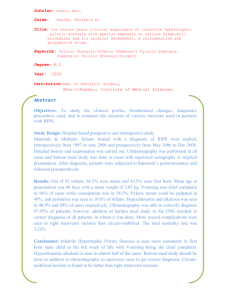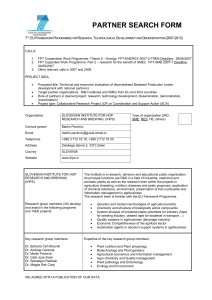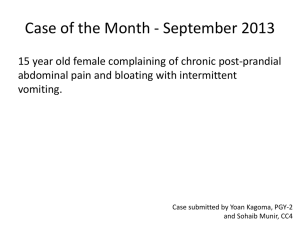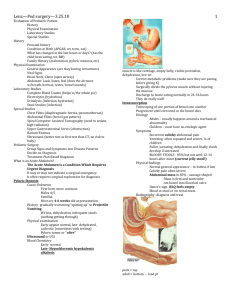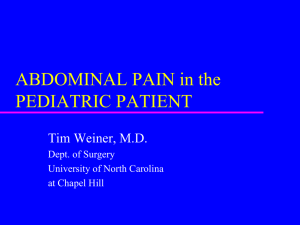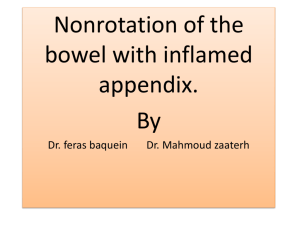7/13/2015 No Conflicts of Interest to Disclose Infantile Hypertrophic Pyloric Stenosis (IHPS) Malrotation
advertisement
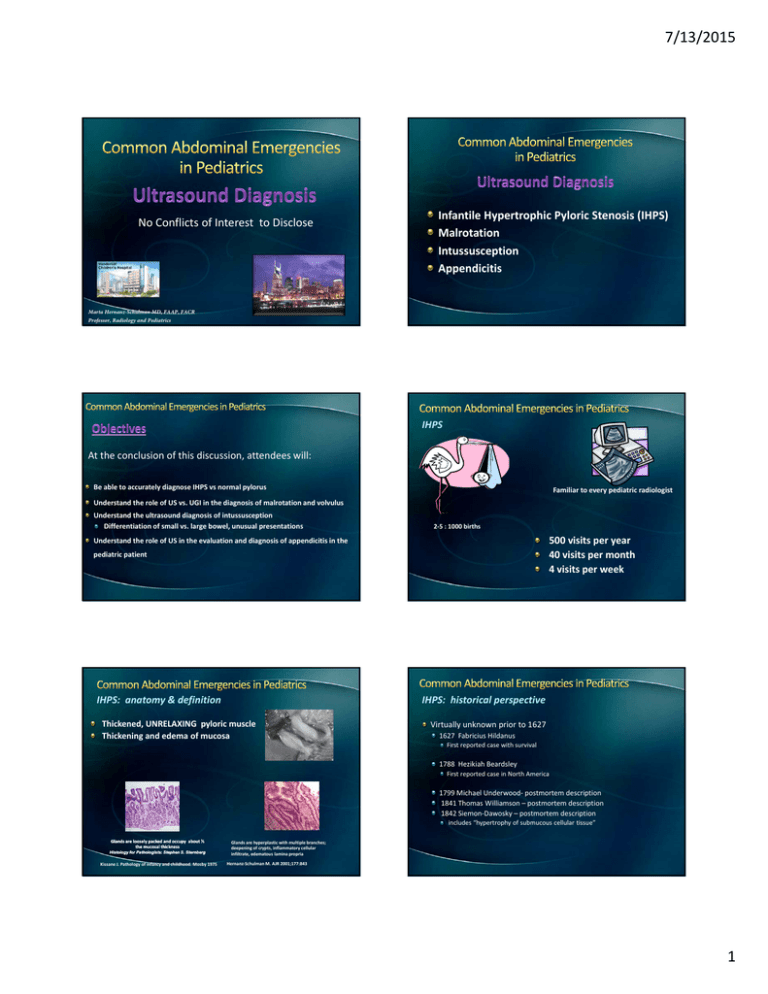
7/13/2015 No Conflicts of Interest to Disclose Infantile Hypertrophic Pyloric Stenosis (IHPS) Malrotation Intussusception Appendicitis Marta Hernanz-Schulman MD, FAAP, FACR Professor, Radiology and Pediatrics IHPS At the conclusion of this discussion, attendees will: Be able to accurately diagnose IHPS vs normal pylorus Familiar to every pediatric radiologist Understand the role of US vs. UGI in the diagnosis of malrotation and volvulus + Understand the ultrasound diagnosis of intussusception Differentiation of small vs. large bowel, unusual presentations 2‐5 : 1000 births 500 visits per year 40 visits per month 4 visits per week Understand the role of US in the evaluation and diagnosis of appendicitis in the pediatric patient IHPS: anatomy & definition IHPS: historical perspective Thickened, UNRELAXING pyloric muscle Thickening and edema of mucosa Virtually unknown prior to 1627 1627 Fabricius Hildanus First reported case with survival 1788 Hezikiah Beardsley First reported case in North America 1799 Michael Underwood‐ postmortem description 1841 Thomas Williamson – postmortem description 1842 Siemon‐Dawosky – postmortem description includes “hypertrophy of submucous cellular tissue” Glands are loosely packed and occupy about ½ the mucosal thickness Histology for Pathologists: Stephen S. Sternberg Kissane J. Pathology of infancy and childhood. Mosby 1975 Glands are hyperplastic with multiple branches; deepening of crypts, inflammatory cellular infiltrate, edematous lamina propria Hernanz‐Schulman M. AJR 2001;177:843 1 7/13/2015 IHPS: historical perspective IHPS: historical perspective 1887: Pediatric Congress, Wiesbaden, Germany The lyf so short, the craft so long to lerne Thassay so hard, so sharp the conqueryinge Geoffrey Chaucer Harald Hirschsprung: 2 infant girls rigorous postmortem description of two cases published 1888: Falle von angeborener pylorusstenose, beobachtet bei sauglingen; Jahrb der Kinderh 27:61‐68 Percent mortality in infants with Pyloric stenosis H. Mack, 1942 Bulletin of the History of Medicine, Year vs. Mortality 100 80 60 40 20 0 1900 IHPS 1900 1920 1940 1960 1980 2000 IHPS: diagnosis 2005 Accurate ? Surgeons: Sensitivity: 31‐100%; Specificity: 85‐99% Non‐surgeons: Sensitivity: 26 - 47% Noninvasive ? empty stomach via NG tube Sedation suggested * Rapid ? 10‐20 minutes; may need to be repeated Accurate ? Sensitivity: 97‐100%; Specificity: 99 ‐100% Noninvasive ? No need to further distend stomach No radiation exposure Rapid ? No need to wait until stomach empties No need to empty the stomach No need to have a calm infant * H Freund et al, Lancet 1976;2(7983):473 IHPS: normal anatomy Pyloric antrum 2.5 cm in length Terminates at pyloric sphincter/orifice IHPS: abnormal anatomy Pyloric antrum is abnormal thickened muscle thickened mucosa 2 7/13/2015 IHPS IHPS Warm room Warm gel Scan infant under blankets Pacifier soaked in D5W 6 ‐7 MHz long footprint linear transducer Patient positioned to bring pylorus into view begin with patient supine turn to right slowly if need to bring fluid to antrum turn to left slowly if pylorus tucked behind distended stomach IHPS: ultrasound characteristics IHPS Thickened muscle ≥ 3mm Identify pylorus Sweep caudally from GE junction anterior to aortic crus. Identify arrowhead‐shaped duodenal cap Landmarks: head of pancreas gallbladder Ultrasound Mucosa fills pyloric channel protrudes into antrum: “nipple sign” Thickened mucosa Usually hyperemic Dimensions may change during study IHPS is NOT a complete obstruction IHPS: ultrasound characteristics Mucosal hypertrophy nipple sign double track sign 3 7/13/2015 Endoscopy Mucosa protrudes through pyloric channel into antral lumen Pyloric stenosis: thickened muscle, mucosa 3.6mm; 10.7mm “Typical endoscopic image of HPS” J pediatr gastroenterol nutr 18:1994 IHPS: pitfalls Failure to visualize the pylorus Overdistended stomach Pylorus tucked behind stomach Normal pylorus: ultrasound characteristics Muscle at rest < 2mm Turn infant to the left, allowing pylorus to rise anteriorly Dimensions may change during study May need observation Turn patient, Add fluid The stomach may or may not empty during study Normal pylorus: pitfalls Borderline measurements empty stomach collapsed antrum Normal pylorus: pitfalls Turn infant to the right Give fluid (e.g., Pedialyte D5W) Borderline measurements peristalsis Watch ………… ! 4 7/13/2015 Normal pylorus: pitfalls IHPS – Questions Beware the GE junction Unknown rate of evolution of pyloric stenosis Unknown whether pylorospasm (failure of antropyloric portion of the stomach to relax, with muscle thickness < 3mm) is self‐resolving in some develops into pyloric stenosis in others IHPS ‐ Questions IHPS: Questions 6 / 145 consecutive patients had borderline muscle thickness ≥ 2 ‐ < 3mm 2/6 developed pyloric stenosis two weeks later 7 / 152 with borderline muscle thickness none developed pyloric stenosis 1 / 75 patients developed pyloric stenosis between 2 weeks of age (intermittent opening, 2.8mm) and 7 weeks (no opening, 3.5mm) 2 wks; 1.7mm O’Keefe et al, Radiology 1991;178: 827 Hernanz‐Schulman et al Radiology 1994;193:771 Hernanz‐Schulman et al Radiology 2003;229:389 4 wks; 2.8mm Intermittent opening 6 wks; 2.8 – 3.5mm No opening IHPS: Questions MALROTATION What happens if US is negative? Reflux Document Treat Duodenal stenosis 5 7/13/2015 Malrotation = Malrotation = Normal Rotation Normal Rotation Duodenojejunal Junction (DJJ) Cecal Loop 0o 90o 180o 270o 180o 270o 90o 0o Malrotation = Incomplete Rotation Malrotation‐ Volvulus Malrotation = Incomplete Rotation = Spectrum Malrotation ‐ Ischemia Malrotation – Clinical presentation 80% present in the first month of life 90% within the first year Acute Obstruction Vascular compromise Bilious vomiting Abdominal distension Hematochezia Hematemesis 6 7/13/2015 Malrotation – Clinical presentation Malrotation – Clinical presentation Malrotation – Clinical presentation Malrotation – Clinical presentation Older patients Recurrent vomiting Recurrent abdominal pain Failure to thrive Malabsorption Malrotation – Diagnosis Malrotation – Diagnosis Gold Standard (?) Reversal of SMA / SMV relationship Detection of Malrotation Sensitivity 93 – 100% Lateral view Sensitivity 96% Detection of volvulus Sensitivity 54% Specificity 88% Sensitivity: 66 ‐ 71% First pass Gastric emptying is variable Duodenal emptying is variable Gastric overdistension with contrast Specificity: 89 – 92% Whirlpool sign: volvulus Twist of duodenum and SMV around SMA Sensitivity: 83 – 92% Specificity: 92 – 100% Dao, Beydoun, Youssfi 245 studies; 100% Sensitivity & Specificity SPR 58th annual meeting, April 2015 7 7/13/2015 Malrotation – Diagnosis US: Whirlpool Sign Malrotation ‐ Diagnosis Case history 8 year old boy long history of failure to thrive recent 14 pound weight loss recent diagnosis of “sprue” on gluten‐free diet Malrotation INTUSSUSCEPTION Intussusception Intussusception DEL POZO ET AL. RADIOGRAPHICS 1999 19:299‐13 Intussusceptum Intussuscipiens 8 7/13/2015 Intussusception Intussusception Diagnosis Tailoring management TECHNIQUE Curvilinear transducer for bird’s eye view Sensitive – 100% Specific – “89%” BOWEL ‐ WITHIN ‐ BOWEL Linear transducer for focused evaluation of bowel‐within‐bowel trapped fluid lead points Ultrasound in the diagnosis and exclusion of intussusception Ir Med J 1997;90:64 Intussusception in children: reliability of US in diagnosis Radiology 1992;191:741 Intussusception Intussusception Increased reduction failure Age < 3 months Duration > 48 hours small bowel obstruction Hematochezia M ENTRANCE Fluid within the intussusceptum complex Diminished or absent flow to complex END Intussusception 6 months – 2 years Intussusception‐ lead points Duplication cyst Ileocolic, idiopathic Lead points < 2‐3 months ‐ duplication cyst, Meckels > 5 years – lymphoma ‐ Burkitt Burkitt lymphoma 9 7/13/2015 Intussusception – small bowel Intussusception – small bowel Asymptomatic < 3 cm wide < 3 cm long No obstruction Active peristalsis Intussusception – small bowel Appendicitis Most common childhood surgical condition 80% of pediatric surgical emergencies Greatest in second decade Rare in young children Neonates‐ appendiceal perforation may be a presentation of long‐segment Hirschsprung disease* APPENDICITIS Appendicitis – Pediatric Challenges Young children unable to verbalize symptoms Presentation atypical in 30‐45% Perforation rates adults 16‐39% children 23‐73% infants 62‐ 88% as high as 100% in infants < 1 year *J Ped Surg 1997;32(1):123 10 7/13/2015 Appendicitis – Diagnosis Appendicitis – Ultrasound Physical examination Typical findings Sensitivity SURGERY Approximately 40‐100% Specificity Atypical findings IMAGING Approximately 40‐95% Underscores Operator Dependence ULTRASOUND Appendicitis – Ultrasound High frequency LINEAR transducer graded compression Gentle and STEADY pressure Upward direction empty bladder visualize psoas CALM INFANT Crying prevents successful compression Toys, videos Appendicitis – Ultrasound Appendicitis – Ultrasound Find liver and right kidney Identify ascending colon noncompressible bowel gas ? Follow ascending colon identify terminal ileum Search for appendix cecal tip, retrocecal area, iliac fossa Appendicitis – Ultrasound Visualization is variable 5 – 50% ENTIRE appendix MUST be visible Base and length may be normal Tip may be hidden by overlying gas 11 7/13/2015 Appendicitis – Ultrasound Appendicitis – Ultrasound >6mm outer‐wall‐to‐outer‐wall during compression Periappendiceal echogenicity Increased flow may not be present if necrosis has supervened APPENDICITIS RLQ PAIN CONTROLS 6 mm Appendicitis – Ultrasound Borderline appendix size Loop of bowel mistaken for appendix Need to confirm blind‐ending structure origin from cecal tip if possible identify terminal ileum separately Rettenbacher et al radiology 2001;218:757‐62 Appendicitis – Ultrasound No appendix identified Hidden by bowel gas or bone Normal appendix identified at cecal pole Inflamed appendiceal tip elsewhere Loop of bowel mistaken for “normal” appendix + 12
